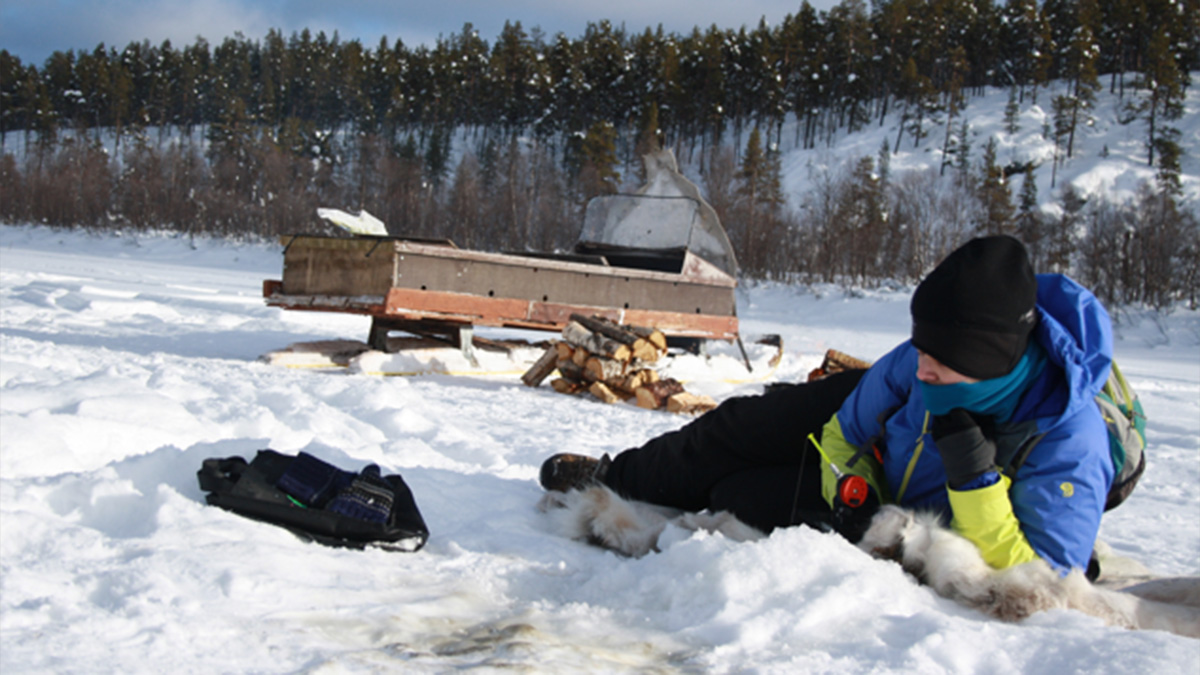When University of Notre Dame Assistant Professor of Anthropology Cara Ocobock chooses field sites for research, she goes to extremes.
Her main research questions revolve around how the human body copes with and reacts to severe environments. Ocobock met fellow researchers in the Arctic in Finland to measure the resting metabolic rate (RMR) of reindeer herders. Their surprising results — that the female herders had higher RMRs than the male herders, when usually men’s rates are higher than women’s — were recently published in the American Journal of Human Biology.
RMR is the total number of calories burned by a human when completely at rest, which is just a part of our total energy expenditure, or total calories burned per day, known scientifically as kcal/day. RMR is closely linked to body size and, since men are generally larger than women, they typically have higher RMRs. Total energy expenditure also includes the energy expended for physical activity as well as the breakdown of food.
“Several studies have demonstrated that cold-climate populations have higher-than-expected RMRs,” Ocobock said. “It is thought this helps maintain body temperature despite low environmental temperatures. However, there is lots of unexplained variation.”
Ocobock and her fellow researchers wanted to compare reindeer herders’ RMRs to those in other extremely cold environments whose high RMRs had been established through other studies. In January 2019, the researchers worked with five female reindeer herders and 15 male reindeer herders who worked near Rovaniemi, Finland — close to the Arctic Circle and known as the “official home of Santa Claus.”
A physically demanding job, reindeer herding includes protecting reindeer from predators, searching for the remains of reindeer lost to predators, repairing fences, feeding and slaughtering reindeer and administrative tasks. To measure their RMR, Ocobock used indirect calorimetry — a noninvasive process in which a mask is placed over participants’ mouths to capture the levels of oxygen they breathe in and carbon dioxide they breathe out. Because it takes energy to digest food, subjects have to fast for 12 hours and abstain from caffeine before the test so researchers can get the true RMR measurement.
Ocobock and her colleagues then got to work trying to determine why the female herders had higher RMRs. They needed to rule things out like the possibility that their female subjects didn’t adhere to the fasting restrictions, but all subjects verbally affirmed that they had and enthusiastically partook in the food and coffee offered to them after their assessments.
They then considered age, as the female herders skewed young and the male herders skewed older. Ocobock and her fellow researchers found that there was no significant difference in RMR between females and males based on age or herding district. Other factors such as genetics and division of labor were also considered and could potentially play a role.
“RMR is also associated with thyroid hormone. We think higher thyroid hormone levels may increase RMR,” said Ocobock. “Thyroid hormone is also critically important for a successful pregnancy. Female herders, even if they use technology to stay warm, may have to maintain higher thyroid hormone levels (and thereby higher RMR) because of the role thyroid hormone plays in pregnancy.”
To support a growing fetus, women’s thyroid hormones increase significantly. Although other researchers have demonstrated that women who live in extreme environments produce more thyroid hormone to adapt to the cold, this is the first study to hypothesize a link with pregnancy.
“In order to maintain a successful pregnancy, cold-climate women must increase TH levels 30 percent to 100 percent higher than an already elevated baseline,” Ocobock and her co-authors wrote. “It is possible that successful pregnancies in cold climates require an absolutely higher TH level than successful pregnancies in temperate or hot climates.”
More research should be done, Ocobock emphasized, to determine an absolute link between high RMRs and pregnancies in cold climates. In future studies, she hopes to recruit more participants and expand physiological data. Taking RMR and thyroid hormone measurements in different seasons is crucial, as well as controlling for women’s menstrual cycles. Importantly, climate change may also play a role.
“The Arctic has experienced the effects of climate change earlier and more acutely than the rest of the world,” Ocobock said. “Higher RMR variability may be indicative of warmer environmental temperatures.”
Original post https://alertarticles.info
